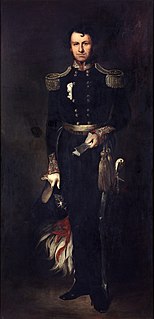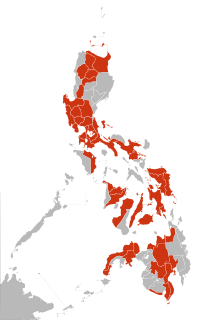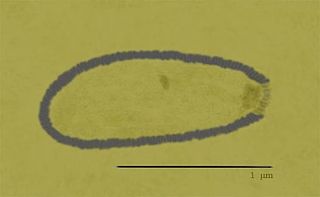Related Research Articles

La Trobe University is a public research university based in Melbourne, Victoria, Australia. Its main campus is located in the suburb of Bundoora. The university was established in 1964, becoming the third university in the state of Victoria and the twelfth university in Australia. La Trobe is one of the Australian verdant universities and also part of the Innovative Research Universities group.

Mimivirus is a genus of giant viruses, in the family Mimiviridae. Amoeba serve as their natural hosts. This genus contains a single identified species named Acanthamoeba polyphaga mimivirus (APMV). It also refers to a group of phylogenetically related large viruses.

Melbourne Central railway station is an underground station on the electrified railway network in Melbourne, Australia. It is one of five stations on the City Loop, which encircles the Melbourne CBD. The station is located under La Trobe Street, between Swanston and Elizabeth Streets, on the northern edge of the central business district (CBD). The station is named after the Melbourne Central Shopping Centre, which it is beneath. It feeds into Melbourne's main metro network station, Flinders Street, and also Southern Cross, Melbourne's main regional terminus. In 2017/2018, it was the third-busiest station on the Melbourne metropolitan rail network, with 15.859 million passenger movements.

A nanobe is a tiny filamental structure first found in some rocks and sediments. Some scientists hypothesize that nanobes are the smallest form of life, 1/10 the size of the smallest known bacteria.

Charles la Trobe, CB, commonly Latrobe, was appointed in 1839 superintendent of the Port Phillip District of New South Wales and, after the establishment in 1851 of the colony of Victoria, he became its first lieutenant-governor.

The Japanese Friendship Garden is a walled section of Kelley Park in San Jose, California, United States. Dedicated in October 1965, it is patterned after Japan's famous Korakuen Garden in Okayama and spans six acres. Its three main ponds were stocked with koi sent from Okayama in 1966. The ponds are at different elevations in the park, and are inter-connected by streams.
John Kinley Dewar is an Australian academic. He is the current vice-chancellor of La Trobe University.

African swine fever virus (ASFV) is a large, double-stranded DNA virus in the Asfarviridae family. It is the causative agent of African swine fever (ASF). The virus causes a hemorrhagic fever with high mortality rates in domestic pigs; some isolates can cause death of animals as quickly as a week after infection. It persistently infects its natural hosts, warthogs, bushpigs, and soft ticks of the genus Ornithodoros, which likely act as a vector, with no disease signs. It does not cause disease in humans. ASFV is endemic to sub-Saharan Africa and exists in the wild through a cycle of infection between ticks and wild pigs, bushpigs, and warthogs. The disease was first described after European settlers brought pigs into areas endemic with ASFV, and as such, is an example of an emerging infectious disease.
The Melbourne City campus of the Royal Melbourne Institute of Technology is located in the city centre of Melbourne in Victoria, Australia. It is sometimes referred to as "RMIT City" and the "RMIT Quarter" of the city in the media.

The 2009 flu pandemic in the Philippines began on May 21, 2009, when a young Filipina girl first contracted the A(H1N1) virus while in the United States. In the following days, several local cases were reported to be caused by contact with two infected Taiwanese women who attended a wedding ceremony in Zambales.

The Drimolen Palaeocave System consists of a series of terminal Pliocene to early Pleistocene hominin-bearing palaeocave fills located around 40 kilometres (25 mi) north of Johannesburg, South Africa, and about 6 kilometres (3.7 mi) north of Sterkfontein in the UNESCO World Heritage Site Cradle of Humankind.
A giant virus, sometimes referred to as a girus, is a very large virus, some of which are larger than typical bacteria. All known giant viruses belong to the phylum Nucleocytoviricota.

The Islamic Museum of Australia (IMA) is a community museum in Thornbury, Melbourne, Victoria, Australia. It began as a not-for-profit foundation founded in May 2010 with the purpose of establishing the first Islamic museum in Australia. It aims to showcase the artistic heritage and historical contributions of Muslims in Australia and abroad through the display of artworks and historical artefacts.
Pandoravirus is a genus of giant virus, first discovered in 2013. It is the second largest in physical size of any known viral genus. Pandoraviruses have double stranded DNA genomes, with the largest genome size of any known viral genus.
Pandoravirus salinus is a large virus of genus Pandoravirus, found in coastal sediments in Chile, and is one of the largest viruses identified, along with Pandoravirus dulcis. It is 2.5 million nucleobases long, encodes for about 2,500 genes, and is visible through an optical microscope. It was first identified in 2013.
Pandoraviridae is a family of double-stranded DNA viruses that infect amoebae. There is only one genus in this family: Pandoravirus. Several species in this genus have been described, including Pandoravirus dulcis and Pandoravirus salinus.

Brodie Grundy is a professional Australian rules footballer playing for the Melbourne Football Club in the Australian Football League (AFL). He was previously an All-Australian and best-and-fairest winner with Collingwood, having been selected with the 18th draft pick in the 2012 AFL draft.

Pithovirus, first described in a 2014 paper, is a genus of giant virus known from two species, Pithovirus sibericum, which infects amoebas and Pithovirus massiliensis. It is a double-stranded DNA virus, and is a member of the nucleocytoplasmic large DNA viruses clade. The 2014 discovery was made when a viable specimen was found in a 30,000-year-old ice core harvested from permafrost in Siberia, Russia.
The La Trobe Student Union (LTSU) is a representative body for students at La Trobe University. The LTSU is located at the Bundoora campus in the Agora. The LTSU is made up of elected student representatives who provide advocacy, services, events and support for all La Trobe Students. The representatives include President, Education Vice President, General Secretary, Postgraduate Officer, Education Public Affairs Officer, Welfare Officer, Women's Officer, Queer Officer, People of Colour Officer, Aboriginal and Torres Strait Islander Officer, Disabilities Officer, Social Justice Officer, Activities Officer and 7 General Members of Council.
Nucleocytoviricota is a phylum of viruses. Members of the phylum are also known as the nucleocytoplasmic large DNA viruses (NCLDV), which serves as the basis of the name of the phylum with the suffix -viricota for virus phylum. These viruses are referred to as nucleocytoplasmic because they are often able to replicate in both the host's cell nucleus and cytoplasm.
References
- ↑ Smith, Bridie (26 July 2013). "Pandoravirus discovered in Latrobe uni pond". The Age.
- ↑ "Pandoravirus promises future surprises, News, La Trobe University". 2018-06-18. Archived from the original on 2018-06-18. Retrieved 2018-06-18.
- ↑ Than, K. (18 July 2013). "Jumbo viruses hint at 'fourth domain' of life". Fox News. Retrieved 18 July 2013.